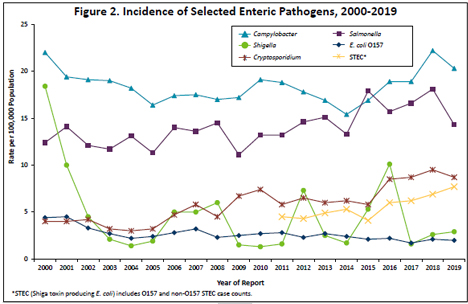Annual Summary of Disease Activity:
Disease Control Newsletter (DCN)
Related Topics
Contact Info
Escherichia coli O157 Infection, Other Shiga Toxin-producing E. coli, and Hemolytic Uremic Syndrome (HUS), 2019
In 2019, 111 culture-confirmed cases of Escherichia coli O157 infection (1.98 per 100,000 population) were reported. The number of reported cases represents a 12% decrease from the median number of cases reported annually from 2009 to 2018 (median, 126.5 cases; range, 96 to 146). During 2019, 59 (53%) cases occurred in the metropolitan area. Sixty-eight (61%) cases occurred during May through October. The median age of the cases was 28 years (range, 1 to 91 years). Eleven percent of the cases were 4 years of age or younger. Forty-five (41%) cases were hospitalized; the median hospital stay was 3 days (range, 1 to 25 days). No cases died.
In addition to the 111 culture-confirmed E. coli O157 cases, 322 cases of Shiga toxin-producing E. coli (STEC) infection were identified in 2019. Among the 322 cases with STEC other than O157, E. coli O103 was the serogroup for 52 (16%) cases, E. coli O26 for 52 (16%), E. coli O111 for 51 (16%), E. coli O145 for 12 (4%), E. coli O121 for 7 (2%), and E. coli O45 for 5 (2%). The median age of the non-O157 STEC cases was 23.5 years (range, 5 months to 95 years). Forty-one (13%) cases were hospitalized; the median hospital stay was 3 days (range, 1 to 56 days). No cases died.
Culture-independent tests (CIDTs) have become increasingly adopted by clinical laboratories for the detection of Shiga toxin in stool. Two hundred fifty-one patient specimens that were positive by a CIDT conducted at a clinical laboratory were not subsequently culture-confirmed, and therefore did not meet the surveillance case definition for inclusion in MDH case count totals.
Five E. coli O157 outbreaks were identified during 2019. Four outbreaks were due to foodborne transmission, and one was due to animal contact. All four foodborne outbreaks were part of national investigations. The five outbreaks resulted in 46 laboratory-confirmed Minnesota cases with a median of 7 cases (range, 5 to 18 cases per outbreak). One outbreak was associated with animal contact at the Minnesota State Fair. Eleven laboratory-confirmed cases were identified. No cases developed hemolytic uremic syndrome (HUS) or died. A national outbreak was likely associated with frozen pizza. Eighteen cases were identified in Minnesota. No cases developed HUS or died. In November, a national outbreak of infections was associated with romaine lettuce from Salinas, California. Seven laboratory-confirmed cases were identified in Minnesota. Two cases developed HUS and neither died. In November, a national outbreak was associated with pre-packaged salad kits. Five laboratory-confirmed cases were identified in Minnesota. No cases developed HUS or died. In December, a national outbreak was associated with iceberg lettuce. Five laboratory-confirmed cases were identified in Minnesota. No cases developed HUS or died.
Seven non-O157 STEC outbreaks were identified during 2019. Four outbreaks were due to person-to-person transmission in child care settings, two were due to foodborne transmission, and one was due to waterborne transmission. A national outbreak of E. coli O103 infections was associated with consuming ground beef. One laboratory-confirmed case was identified in Minnesota. The case did not develop HUS or die.
An outbreak of E. coli O26:H11 infections associated with person-to-person transmission occurred at a childcare facility in Hennepin County. Six cases, all laboratory-confirmed, were identified. No cases developed HUS or died. A second outbreak of E. coli O26:H11 infections associated with person-to-person transmission occurred at a childcare facility in Hennepin County. Four cases, all laboratory-confirmed, were identified. No cases developed HUS or died. Another outbreak of E. coli O26:H11 infections associated with person-to-person transmission occurred at a child care facility in Olmsted County. Two cases, both laboratory-confirmed, were identified. Neither case developed HUS or died. Another outbreak of E. coli O26:H11 infections associated with person-to-person transmission occurred at a childcare facility in Wright County. Thirty-six cases, including 20 laboratory-confirmed, were identified. No cases developed HUS or died.
In August, an outbreak of E. coli O145:H28 infections was associated with a waterborne transmission at a lake in Hennepin County. Sixty-nine cases, including 4 laboratory-confirmed, were identified. No cases developed HUS or died.
An outbreak of E. coli O69:H11 infections was associated with a restaurant in Anoka County. Three cases, all laboratory-confirmed, were identified. No cases developed HUS or died.
Hemolytic Uremic Syndrome (HUS)
In 2019, 11 HUS cases were reported. The number of reported cases is similar to the median number of cases reported annually from 2009 to 2018 (median, 12.5 cases; range, 9 to 17). In 2019, the median age of HUS cases was 7 years (range, 1 year to 78 years); 6 of the 11 cases occurred in children <7 years of age. All 11 cases were hospitalized, with a median hospital stay of 15 days (range, 3 to 25 days). No cases died. From 1997 through 2019, the overall case fatality rate among HUS cases was 5.0%. Ten of the 11 HUS cases reported in 2019 were post-diarrheal. E. coli O157:H7 was cultured from the stool of 7 cases, E. coli O111:H8 was cultured from the stool of 1 case, and E. coli O55:H7 was isolated from the stool of 1 case. In 2019, there were 2 outbreak-associated HUS cases, both associated with a national outbreak due to romaine lettuce from Salinas, California. Both outbreak-associated HUS cases were hospitalized; the median hospital stay was 9 days (range, 3 to 15 days). Neither case died.

- For up to date information see:E. coli O157:H7 and HUS
- Full issue>> Annual Summary of Communicable Diseases Reported to the Minnesota Department of Health, 2019